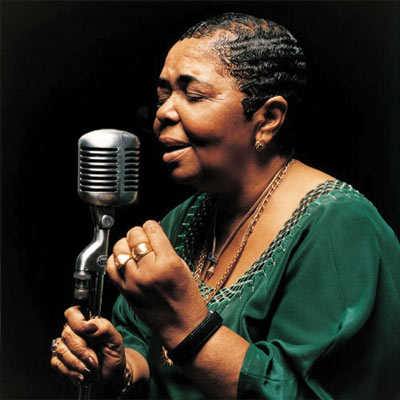Cesaria Evora’s Unforgettable Voice Transcends Nostalgia
Drinking the Honey

Does the soul of a song lie in literal meaning, in which case the listener must understand the song’s language? Or, does the song travel through the ear to infuse itself within its listener’s soul, for which language comprehension no longer matters? Last Friday, I sat on a wooden bench at El Capitan, and Cesaria Evora and her communications manager sat in Montreal, safe from the notorious El Cap gnats, and listened to my questions. Our conversation swiftly traveled from English to French to Portuguese to Creole and back to French.
Cesaria Evora is an internationally recognized diva. She comes from Cape Verde, an archipelago of 10 islands off the western coast of Africa. The “barefoot diva” will be gracing UCSB’s Campbell Hall with her lovely morna music in October. At 67, Evora has had a tumultuous, lifelong singing career, which seemed to stabilize only at age 47. It all began in the orphanage choir where Cesaria Evora learned to sing. From there, Evora was guided by various Cape Verdean musicians and composers such as her father, B. Leza, Gregorio Gon§alvez, and her first love, Eduardo. Dubbed the “Queen of Mornas,” Cesaria Evora became known around the islands as the “Voice of Cape Verde.” She made her debut in the bars of Mindelo, the main port city of S£o Vicente, one of the cape’s islands.
However, after a time, her local fame began to stagnate. By 1975, Evora had been pulled in so many different directions that she was worn out. She stopped performing in public and regressed into a period of 10 years that she labels as her “dark.” “I had had enough of singing one night. Nothing seemed to be coming out of it. I stopped from ’75 to ’85 and naturally picked it up again later.” A Portuguese singer, Bana, helped her slowly recover her career. Finally, singing in a restaurant owned by Bana, Evora met Jose da Silva. This was the turning point-the stepping-stone into her present day career. After falling in love with Cesaria Evora’s Portuguese SG-brand cigarette-tinged voice, Jose da Silva became her mentor and producer. He proposed that she come with him to record in Paris, France. This was in 1988. That’s when-finally-our morna diva really made it. By releasing her first French album La Diva aux Pieds Nus (The Barefoot Diva), Evora launched her late-starting international career with a carefree spirit born out of long years of waiting. By then, she had nothing to lose and everything to gain.
Yet despite her fondness for the France of her fame and success, Cape Verde will always come first. She said that she “cannot compare Cape Verde to any other place. It’s unique. There is no gold, no diamonds, no oil, but there’s this natural richness. Nothing is dramatically special-just a superb climate, and the unpolluted sea. Every island is different from one another. We have sun from the first of January to the thirty-first of December. And after this tour, I will be returning to my island October 20.”
Most naturally of all, Cesaria Evora is a singer. Though she loves many artists, she claims she has no influences. Singing is simply a natural fact for Cesaria Evora, like having toes, fingers, and eyes. On the other hand, fame followed her more impulsively than music. As she put it, “Success-we don’t know where it comes from, or where it’s born.” In 2003, the barefoot diva was awarded a Grammy for her album Voz d’Amor (Voice of Love). Now, Cesaria Evora sees her life as the calm after the storm, asserting that “what delights me today is the happiness of having got through all the years of suffering to better enjoy the life I live now. At home, we say it’s better to drink the venom first and the honey later. Now, I’m drinking the honey.” An incredibly humble woman, Cesaria Evora sees her life as “nothing special, a normal life with family, kids-nothing special.”
Cape Verde’s national music is called the morna. Similar to the Portuguese fado, it bears hints of the Argentinian tango and the Brazilian modinha, and is accompanied by an Angolan chanting style. The morna is sung in Cape Verdean Creole accompanied by violin or viola, guitar, cavaquinho (Portuguese guitar), and soft percussion on maracas.
Above all, the morna is poetry. The morna is simply the musical term for the Portuguese word sodade. The word “sodade” is specific to the Portuguese language and cannot be properly translated into any English term. Those who do attempt to translate relate sodade to nostalgia, but Evora clearly told me that the sodade is a much more elevated feeling than nostalgia: “It’s a sentiment deeper than nostalgia, one that tears the heart because of separation from a lover or from home. This suffering is one you cannot forget. It’s a fact. It’s always present.” Hence, most of Cesaria Evora’s songs are mornas expressing her sodade. Evora’s tobacco- and cognac-infused voice pairs perfectly with the elegant and graceful morna. The diva’s bass voice makes it sound as though each note’s heavy melancholy emerges from the depths.
4•1•1
Cesaria Evora performs her past international hits and introduces Santa Barbara to her newest album, Rogamar (Praise to the Sea), at UCSB’s Campbell Hall on Tuesday, October 7, at 8 p.m.



